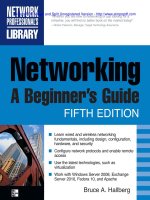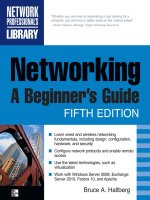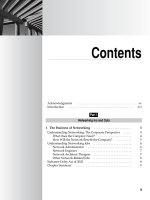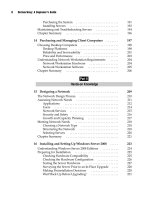Networking: A Beginner’s Guide Fifth Edition- P14 docx
Bạn đang xem bản rút gọn của tài liệu. Xem và tải ngay bản đầy đủ của tài liệu tại đây (361.92 KB, 5 trang )
47
Chapter 4: Understanding Network Cabling
of Token Ring networks are offset somewhat by the greater overhead and processing
needs to handle the tokens. Overall, Token Ring networks perform about as fast as
Ethernet networks with similar bandwidth.
IBM invented the Token Ring network technology in the late 1960s, and the
first Token Ring networks started appearing in 1986. While quite a few Token Ring
LANs are installed (running at either 4 Mbps or 16 Mbps), you tend to see them
predominantly in companies that have a strong IBM relationship and, perhaps, also use
an IBM mainframe or minicomputer.
If you’re designing a new LAN, generally your best bet is to use Ethernet in a
star topology. You’ll find network equipment for this choice is readily available and
inexpensive. Many qualified installers are available for 100Base-T or 1000Base-T.
(There is little sense in installing 10Base-T these days; in fact, the equipment is no
longer available.) As noted earlier, for new networks, you should install Cat-5E cable
at a minimum, even if you’re initially going to use 100Base-T, so that you have a ready
upgrade path to the faster standards.
Use Token Ring if some external need is driving this choice, such as connectivity to
an old IBM mainframe that doesn’t support Ethernet.
Demystifying Network Cabling
Network cabling can be incredibly confusing. Not only are there many different types
of network cables—all with their own names and properties—but often you can select
different types of cables for a single type of network. For example, Ethernet networks
can use an astonishing number of cables, ranging from coaxial cable, to unshielded
or shielded twisted-pair cable, to fiber-optic cable. To design or support any given
network, you need to know your cable choices and how to maintain the particular type
of cable you select.
The focus in this section is to demystify cabling systems for you. It covers the
most common types of network cable—the kinds that you’ll find in 99 percent of the
networks in existence and that you’ll use for 99 percent of any new networks. When
appropriate, I will make passing reference to other cable types so that you know what
they are, but you should focus your attention on only a few ubiquitous cable types—
primarily the ones discussed here.
Overview of Basic Cable Types
The most common network cable types are unshielded twisted-pair (UTP) and
coaxial, followed by shielded twisted-pair (STP) and fiber optic. UTP is by far the most
common type in use today.
UTP cable consists of two or more pairs of plastic-insulated conductors inside a
cable sheath (made from either vinyl or Teflon). For each pair, the two conductors are
twisted within the cable, helping the cable resist outside electrical interference. Rigid
standards exist for how this cable is made, including the proper distance between each
twist of the pair. Figure 4-5 shows an example of UTP cable.
48
Networking: A Beginner’s Guide
STP is similar to UTP, but STP has a braided metal shield surrounding the twisted
pairs to further reduce the chance of interference from electrical sources outside
the cable.
Coaxial cable consists of a central copper conductor wrapped in a plastic insulation
material, which is surrounded by a braided wire shield and, finally, wrapped in a
plastic cable sheath. (The coaxial cable used for televisions is similar in design.) Two
main types are used for networks: Thin Ethernet (10Base-2), which uses RG-58/AU or
RG-58/CU cable, and Thick Ethernet (10Base-5), which uses—you guessed it—a much
thicker coaxial cable called RG-8. Figure 4-6 shows an example of coaxial cable.
Fiber-optic cable uses a glass strand and carries the data signals as light instead of
electricity. It used to be that fiber-optic cable was required for higher-speed networks,
but this is changing, and often UTP or STP can be used instead. This is good news, as
fiber-optic cable is extremely expensive to purchase, install, and maintain. However,
fiber-optic cable can do one thing that copper cables cannot: span extremely long
distances. Fiber-optic cable can easily reach two miles at 100 Mbps. For this reason,
fiber-optic cable is often used to connect together buildings in a campus-like setting.
But other than when you need to span very long distances, you should avoid fiber-
optic cable.
Twisted-Pair Cabling: The King of Network Cables
For a number of years, virtually all new networks have been built using some form of
twisted-pair cabling. Usually, Cat-5 grade twisted-pair cable is used, although you may
see some old networks in which Cat-3–grade cable is installed. UTP is used instead of
STP in almost all cases, because it’s less expensive, easier to install and maintain, and
Figure 4-5. UTP cable
Twisted pairs
Figure 4-6. Coaxial cable
Braided metal shield
Conductor
Plastic
49
Chapter 4: Understanding Network Cabling
not much affected by electrical interference (even without the shield). Both Ethernet
and Token Ring networks use twisted-pair cabling. Note that different Ethernet types
require different cables, and some higher-speed standards require STP.
When a new twisted-pair network is installed, a number of wiring components
form the complete run from the workstation to the hub. As shown in Figure 4-7, the
cabling starts at the hub, where a patch cable (usually 6 to 10 feet long, or 2 to 3 meters)
connects a port on the hub to a patch panel, using RJ-45 connectors on each end. On the
other side of the patch panel, the twisted-pair cable is hard-wired to the patch panel
connection, and then runs continuously to a wall jack (in an office, for instance) to
which it is also hard-wired. The wall jack contains an RJ-45 connector on its other side,
to which another patch cable connects, and then connects to the computer’s network
interface card (NIC). The distance from the connector on the hub to the connector on
the computer’s NIC cannot exceed 100 meters (328 feet) of cable length.
Anywhere twisted-pair cabling isn’t hard-wired, it uses RJ-45 modular connectors.
These are just like the modular connectors you see on telephones, but they are larger
and can accommodate up to eight wires. 10Base-T and 100Base-T use four of those wires
(two pairs: one for transmit and one for receive). 1000Base-T uses eight of those wires.
Figure 4-7. A typical twisted-pair network wiring arrangement
50
Networking: A Beginner’s Guide
The eight wires in the RJ-45 connector are numbered from one to eight. If you were to
hold the connector in your left hand, with the pins in the connector facing up and pointed
forward, pin 1 of the connector is the one farthest away from you (see Figure 4-8).
Table 4-1 shows both the colors of standard Cat-5 cable that should be wired to each
pin and the 10/100Base-T assignments.
DCE and DTE Wiring
Most communications and network devices, including those designed to use RJ-45
connectors, are either data communications equipment (DCE) or data terminal equipment
(DTE). If you have DTE on one end, you need DCE on the other end. In a way, they’re
just like screws and nuts. Two screws don’t go directly together, and neither do two
nuts. The same principle applies here: DCE devices can’t talk directly to other DCE
devices, nor can DTE devices talk directly to DTE devices.
The RJ-45 jack on a hub or switch is DCE, while the RJ-45 jack on a computer’s
NIC is DTE. Note that you cannot communicate between DCE and DCE devices or
between DTE and DTE devices using a standard twisted-pair/RJ-45 cable that has been
Figure 4-8. An RJ-45 connector
Table 4-1. 10/100Base-T Wire Assignments for RJ-45 Connectors
Pin Number Wire Base Color Wire Stripe Color 10/100Base-T Use
1 White Orange Transmit negative
2 Orange White Transmit positive
3 White Green Receive negative
4 Blue White Not used
5 White Blue Not used
6 Green White Receive positive
7 White Brown Not used
8 Brown White Not used
51
Chapter 4: Understanding Network Cabling
wired as described in Table 4-1. For instance, you cannot use a standard twisted-pair
patch cable to connect directly from a network server to a workstation, or between two
workstations, because those are all DTE devices. Instead, you must purchase or prepare
a crossover cable for this connection. For 10/100Base-T networks, Table 4-2 shows the
wiring needed for a crossover cable.
TIP You can easily purchase all the tools and parts needed to make twisted-pair/RJ-45 cables,
and you should do so if you manage a network of any appreciable size (more than 50 workstations).
Knowing how to use these tools and parts to make patch cables or to replace a failed cable is
invaluable. This way, you can quickly make cables of any length you need. However, even though
you should be able to do this, and it can get you out of a jam quickly, you’re better off purchasing
premade twisted-pair/RJ-45 cables to use with your network. Professionally made cables are more
reliable and should give you fewer problems than the ones that you make yourself. Make your own
cables when you’re in a pinch.
What’s All This About Cable Categories?
Twisted-pair network cables are rated in terms of their capability to carry network
traffic. These ratings are defined by the Electronic Industries Alliance (EIA) and the
Telecommunications Industry Association (TIA) and are referred to as Levels 1 and
2 and Categories 3, 4, 5, and 6. The different category levels are simply called Cat-3
through Cat-6. Table 4-3 shows the rated performance for each of these levels.
To achieve a particular performance rating in practice, you not only need cable
certified to that performance level, but you must observe other requirements, including
using connectors and patch cables that also meet that level of performance. For
example, for a Cat-5 installation, you must have Cat-5 cable, connectors, patch panels,
and patch cables. The entire circuit, from where the client computer connects to the hub
connection at the other end, needs to be tested and certified to the performance level
you need to achieve.
Table 4-2. Twisted-Pair/RJ-45 Crossover Cable Wiring
Cable End 1 Cable End 2
Pin Wire Base Color Wire Stripe Color Pin Wire Base Color Wire Stripe Color
1 White Orange 1 White Green
2 Orange White 2 Green White
3 White Green 3 White Orange
6 Green White 6 Orange White









